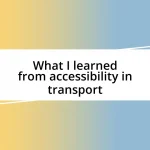Key takeaways:
- Mixed-use developments foster a sense of community and belonging through enhanced social interactions and convenience.
- These spaces stimulate economic growth by creating diverse revenue streams, job opportunities, and resilience during economic downturns.
- Effective mixed-use planning requires community involvement, flexibility in design, and connectivity to ensure that developments reflect local needs and values.

Understanding mixed-use development benefits
One of the most rewarding aspects of mixed-use development is the sense of community it fosters. I remember visiting a vibrant neighborhood where shops, offices, and homes were beautifully intertwined. The atmosphere felt alive, buzzing with activity, and I couldn’t help but feel a sense of belonging just walking down the street. Isn’t it fascinating how a well-designed space can make you feel more connected to your neighbors?
Mixed-use development also offers incredible convenience. Imagine living steps away from a café where you can grab your morning coffee, or a grocery store just a short walk from your front door. Personally, I’ve experienced the joy of living in such a setup; it transformed my daily routine and made my life feel less rushed. Doesn’t that sound like a dream?
Moreover, these developments often contribute to economic sustainability. When businesses thrive in a mixed-use environment, they create jobs and stimulate local economies. I’ve seen small local shops flourish in such areas, drawing in regulars who appreciate the variety and personal touch. Can you think of a time you supported a local business that made your day just a bit brighter?

Key advantages of mixed-use spaces
The versatility of mixed-use spaces is one of their most compelling advantages. I recall visiting a place where I could easily transition from a workspace to a vibrant dining area in the evening. The ability to seamlessly shift environments made it feel like every part of my day was enriched by those transitions, creating a rhythm that was both productive and enjoyable.
Here are some key advantages of mixed-use spaces:
- Enhanced walkability: Residents can easily access shops, parks, and services on foot, promoting healthier lifestyles.
- Diverse revenue streams: Combining residential, commercial, and retail spaces allows for varied income sources, which can stabilize the local economy.
- Social interaction: These spaces facilitate community engagement, helping to eliminate the isolation often felt in single-use developments.
- Environmental benefits: By reducing the need for cars, mixed-use developments can lessen traffic congestion and carbon emissions.
- Increased property values: Vibrant, well-planned mixed-use areas tend to attract higher demand, boosting real estate value over time.
From my experience, being part of a mixed-use community feels like engaging in a constant tapestry of life, where every thread contributes to a richer, more dynamic neighborhood. It’s not just about convenience; it’s about creating a home where you truly feel alive.

Promoting community engagement and interaction
Promoting community engagement and interaction is a hallmark of mixed-use development. I once participated in a local event at a mixed-use plaza, where neighbors gathered for live music and artisan markets. The shared laughter and conversations fostered connections that extended beyond the event itself. It was a reminder of how spaces designed for social interaction can truly enrich our lives.
These developments create opportunities for spontaneous encounters, knitting the fabric of community together. I vividly remember a morning at a mixed-use coffee shop where I bumped into an old friend. We hadn’t seen each other in years, and that chance meeting led to a deep discussion over lattes about life and aspirations. Experiences like this illustrate how mixed-use spaces can deepen our social networks and promote community ties.
Individuals within the community also have a voice in the activities and events held in these spaces, allowing for more inclusive neighborhood engagement. In my own experience, I’ve seen how even a simple survey for community preferences can lead to events that reflect diverse interests. When folks feel their input matters, it strengthens their connection to the place and the people around them.
| Aspect | Mixed-Use Development |
|---|---|
| Community Engagement | Creates vibrant social hubs where people can gather and interact. |
| Spontaneous Connections | Encourages unplanned meetings that foster relationships among residents. |
| Inclusive Activities | Allows community input on events, enhancing local culture and participation. |

Enhancing economic growth opportunities
The economic value of mixed-use developments can be truly transformative. I remember my excitement when a new mixed-use project opened in my neighborhood; it brought a variety of businesses and services under one roof. That not only created jobs but also attracted people from surrounding areas, amplifying the vibrancy of our local economy. Can you imagine witnessing your community flourish like that?
Moreover, the diverse revenue streams generated by these spaces can act as a buffer against economic downturns. I’ve seen communities where a mix of retail, office, and residential uses provided stability during tough economic times. When one sector struggles, the others can often sustain the local economy, which is a comforting thought for residents and business owners alike.
Investment in mixed-use projects can stimulate further development. One day, while sitting at a coffee shop in a space that was previously underutilized, I overheard discussions about new businesses considering the area. It struck me that the improvement of the local landscape could encourage entrepreneurs to set up shop, creating a ripple effect of innovation and growth. Isn’t it fascinating how adaptive reuse can ignite economic opportunities in places that once seemed stagnant?

Improving sustainability and reducing impact
Improving sustainability in mixed-use developments is not just a trend; it’s a necessity. I recall touring a new mixed-use project where the developers incorporated green roofs and solar panels. The pride the community felt in these environmental choices was palpable; it created a sense of ownership and shared responsibility for protecting our planet. Isn’t it inspiring to think how a single development can lead to a collective movement toward sustainability?
Another advantage is the reduction of our carbon footprint. Living, working, and playing within close proximity means fewer car trips. I’ll never forget the first time I walked to a nearby grocery store instead of driving. The fresh air and the chance to interact with neighbors along the way amplified my appreciation for urban living. It struck me that every small decision can contribute to a larger impact on the environment.
Lastly, mixed-use spaces often prioritize public transportation and cycling infrastructure, making these eco-friendly options more accessible. I remember feeling particularly thrilled when a bike lane connected my neighborhood to the city center, giving me the perfect excuse to dust off my bicycle. It highlighted how thoughtful planning leads to healthier lifestyles and fosters communities that prioritize sustainability. Why wouldn’t we want to create spaces that encourage such positive habits?

Strategies for effective mixed-use planning
Effective mixed-use planning requires a balanced approach that prioritizes the needs of the community. I remember attending a town hall meeting where residents shared their visions for local development. Listening to their ideas about parks, shops, and community spaces inspired both the planners and me—it’s crucial to involve the community in the planning process. How can we truly create spaces that reflect our values without hearing from the voices that matter?
Integrating flexibility into the design is another key strategy. One project I visited featured modular spaces that could adapt to changing needs over time. This concept really resonated with me because it emphasized the importance of evolution in urban design. Instead of locking ourselves into a single use, why not create environments that can transform as the community evolves?
Lastly, fostering connectivity within and between spaces can cultivate a sense of belonging. I recall a vibrant square at a mixed-use site, bustling with people enjoying outdoor cafes and colorful markets. It struck me how connections—be it physical pathways or social interactions—make a real difference in creating vibrant communities. Isn’t it amazing how planning can shape not just a place, but the relationships that thrive within it?














